VaporBonus: SF Earthquake, 1989
Return to Chapter 36
Return to Chapter 37
On-shore breezes were kicking up, though not strongly enough to take the heat off, or to chill down phantom traces of the North Point/Diviz inferno—at least to my mind. Suddenly re-feeling the tremors, the whip-snap roiling turbulence: I wanted to blurt out an offhand ‘what say we turn back?’, but couldn’t get a grip on that. B-bam! Then the mildest of aftershocks shook me loose, the concrete sidewalk jiggering out from under me like a wave-swept boogie board, sending me momentarily back to Loma Prietaland…in something of a self-induced seismic…seizure…
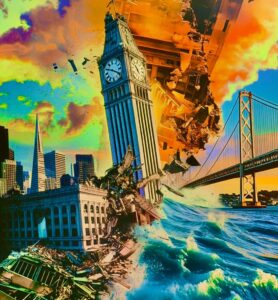
Sure enough, to be there—although it wasn’t all that easy to see at first glance. Had to have been there, was there myself, gone up in smoke and soaked, smoldering debris, nearly twenty long, Richter-light years ago….
Re-picturing that very next morning, October 18, 1989, wandering downhill into the District after a long, eerie, simmering night before, overviewing a blacked-out city under a nearly full-blown hallow moon. I’d nibbled a half-tin of stale Pringles while Doyle Drive backed up from the lone bridge out of town, headlights chain-beaming along Lombard Street, the Golden Gate towering in the hellacious backflow of the iconic Divisadero blaze, a 50-foot wall of flames. My home-fires calmed, damage controlled up in Pacific Heights, I had nosed my way past traffic cordons and cop barricades, slogging leerily down here amid snaking Marina side streets in tumult and ruin, not knowing what I might find.
Assured he would be taking care of her—like he always said, he was fully capable of looking after things—would have it all, as it were, under control, that she’d be shielded and otherwise spared, like Blackie Norton shielding songbird Mary Blake from Market Street before and after the Flood Building. But such psychic reassurance and retrievalizations soon began dissolving like the Marina landfill.
For this hollowed ground we all walked on yet today was originally mere ballast and Bay dredgings poured in for the 1915 Pan-Pacific International Expo, a makeshift sand and sledge dump too voluminous to be twice removed. What better a foundation to build on, asked some early Depression Era hustler/developers: yessir, slap up a whole new neighborhood of tacky Mediterranean-style tinderboxes on the stuff, call it the Marina, being that it was down here atop the bay. Something of a flotilla of pseudo-villas with seedling gardens, crammed single-by-multi-unit along curvaceous side streets with thematic names like Prado, Retiro, Alhambra and Rico Way—no daylight nor breathing room between them—sort of pieds-a-tiramisu, all spongy and aquiver from the start. An answer came with crushing dispatch, some 60 years later, at 5:04 pm. 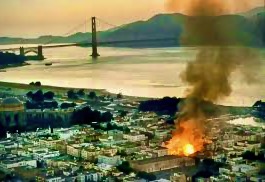
Local seismologists had labeled it a strike-slip quake after the fact, would that they had actually described it: Pacific coastal and continental plates nudging along the gaping San Andreas faultline, epicentering at Dark Hill, over 50 miles south of San Francisco. Richtering in at 7.1, the Loma Prieta Quake lasted less than 30 seconds, rippling out concentrically over the entire Bay Area, the Marina no less included, no cheap shots hereabouts, on the western bend of the Pacific ring of fire…
Naturally, San Francisco Bay reclaimed the Marina’s vulnerable gellulite landfill in short order, water table rising, sandy soil lifting, jerking, falling violently. The District’s rickety structures, garage door where solid walls should be, were no match for the resulting liquefaction, rolled by Loma Prieta’s temblor and its 4-point aftershocks, soft-story foundations and first floors folding quicker equity theater on such shaky ground. Mid-block Spanish bungalow homes imploded, corner Deco-detailed apartment buildings hula danced, tipped on over—suddenly everything went trapezoidal and rhomboid—total local blackout as the whole outside series crowd was watching worldwide. Stunned Giants baseball players milled about homeplate as if they’d just been collectively bean-balled; A’s teammates looked to jack one another out of the yard, squad cars converging around the infield of a panic-rocking Candlestick Park celebrating its 29th year. Meanwhile, Marina sewers spit up, water mains ruptured, gas lines snapped like pretzel sticks: Then came the flames.
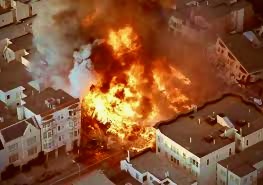
By this morning next, the damage and detritus of nature’s blindside fully registered, and hit like a sickening deathblow. Bulging platelets, post-tectonic shifts: Once past wedged police squadrols and makeshift metal barriers, I witnessed a usually trim, well broom-swept Mallorca Way in staggering disarray. Dwarf trees were trampled, garbage cans upended, planter crocks shattered and spilled, façade ivy torn away, as though a pod of killer whales had submarined on through like a colonoscopy gone a crapper. Crowds already milled around in stupefied dismay from a mammoth drunken spree to right homes about, schlepping any precious belongings they could grab.
Mallorca ahead was a tight tan jumble of bay-style window wells and broken tile rooflines of only marginally varying heights, soon curving westward into far, far worse. Such stiff, wood-frame structures seemed increasingly precarious, as if struggling to hold one another up, straphangers on a lurching subway train. Anguished cries of discovery echoed off the corrugated homefronts, as did the wail of emergency sirens: ambulances, fire trucks still racing into and out of this emerging disaster area. And around the curve toward Alhambra Street, it became clearer what a few seconds of seismic flexing had arbitrarily wrought.
That’s about where I began spotting the unhinged, flapped-out garage doors and collapsed brickface foundations, narrow arching doorways, recessed garage ports, scrawny Urban Forest trees, fire-escape ladders scissoring down—house after building unable any longer to support the sinking stories above. City blocks of Marina structure—more tans and tints flagged and pitched like Slinky toys—Moorish detailed apartment houses twisted downward like accordions left to their own devices on a thumping beer hall stage. Jello soil and cheesy construction: What a decidedly unappetizing combination.
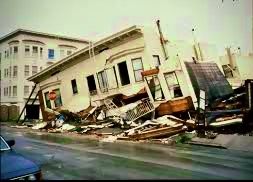
San Francisco’s rebirth in the wake of the 1906 earthquake was torn asunder by the next biggest bang to come along… Loma Prieta’s thrusting right lateral slip had kneaded this sand-filled former lagoon, brackish bay water flooding up, saturating the grains, setting much of the Marina District in violent motion, relentless as a stadium wave. The underlying mess oozed like raw syrup down Pierce and Alhambra Streets, erupted in localized volcanoes through fractured asphalt on Mallorca and Casa Way. Water pressure had hit bottom and the sewers were spitting up. Geologists diagnosed it as acute liquefaction, and the worst part was all that had been dragged along for the ride.
Coming upon Avila, then Scott Streets, it became a matter of following the firehoses, splayed like penne pasta back then—block upon block, curb over curb, hydrant to bone-dry hydrant. Word was pressure had so weakened fighting last night’s blazes, fireboat Phoenix moored in Marina Green harbor (yes, that Marina Green) to pump bay water from several blocks away. But most post-quake fires had been doused by now, including that gas-fed inferno at Beach and Divisadero, where hot trolley wires were dangling, the Moorish pink Claire Lilienthal School had long been evacuated.
Parched crews in neon-striped turnouts fought that five-alarm wall of flames for more than four hours, eventually pumping in water from as far away as the Palace of Fine Arts pools. Absent such valiant department and volunteer efforts, had there blown the usual late-day breezes, gawkers, ankle deep in firewater and goulashed debris kibitzed, the entire damn District would be toast. Not that what was salvaged here was much consolation come the next light of day.
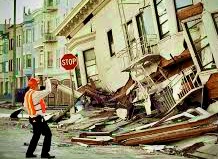
Trodding this main four-block strike zone, the gathering crowds’ shrieks and gasps erupted with every devastating revelation. Sparks, ashes, cinders and embers coarsened the air as weary fire crews continued hosing down smoldering ruins, yet couldn’t douse the depth and enormity of this post-tectonic destruction. Here, the Marina looked to be somewhere between a grotesque landscape by Dali and Gehry’s Bilbao—tilted and distorted, angled and askew. Helmeted cops bullhorned bewildered residents and interlopers alike around the smoky, teetering rubble at Scott and Beach Streets, the dusty three-story collapse job at North Point and Divisadero, the pancaked house near Jefferson and Broderick. Early guesstimates had more than six structures fully down, but who was counting? It was all a body could do to stoically absorb the tragic imagery and gruesome details that lay before us…
Turn any of these corners, substructures had risen, ceilings had fallen—load walls had caved and crumbled in unbearably unimaginable ways. Four-story apartment buildings folded like circus tents to but two or three upper floors, crushing long-term tenants, housepets, garaged cars—anyone or anything so shortsighted as to have chosen lower rent over a view. Charming six-figure matchboxes snapped like stick figures off their slab foundations, some twisting grotesquely and downsliding into heavy traffic. Others knelt for forgiveness onto the Marina’s narrow, winding side streets—many now thoroughly clogged with haphazardt iron railings tangled into tan, twisted fire escapes, which rained down around brick faced lower floors.
Crushed, flattened in the process were furnaces, boilers, major appliances—not to mention erstwhile garage spaces full of premium marque sports and luxury wheels. When possible, volunteers and Samaritans unknown had already propped up tee piles of shingled alluvium. Singed off-white and pastel stucco had peeled away like stale birthday cake icing, exposing splintered lath and plaster, bad drywall, weathered redwood slats and compound-fractured framing. Plumbing pipes, black wroughtering walls and bay window casings with salvaged 2x4s. Riveting, indelible scenes surfaced of splintered 4x4s holding up whole sliding structures, like so many corrupted third-world autocrats.
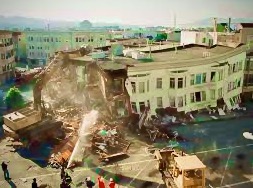
But beyond the gutter mounds of slag and buckled pavement, the steaming heaps of household refuse piling up on sidewalks to either side, what really started getting to me were visions of local laggards stumbling out curtsied, parallelogram doorways and pretzeled window casements with nary the clothes on their fat, sassy backs, leaving everything they’d long cherished and hoarded to be compacted into drenched layers of furniture, furnishings, wall hangings and housewares, floor by caving floor. Glimpses of others defiantly tunneling in and out of their precarious properties, clutching lockboxes and irreplaceable family photos of wool-suited survivors of 1906’s 5:12 am quake, or clawing furiously on all fours through the rubble of their lives to rescue pet cats and dogs. Then there were the aged and immobile, rent-controlled into place for decades, too panic-stricken to budge from their mashed and mangled routines—even as their shrinking worlds crashed down about them. That spectre only spread more viciously as emergency sirens wailed from block to block.
Yellow caution tape wrapped off the most hazardous damage—detached homes, kneeling 18-unit apartment buildings, toppled cactus palm trees, dismembered columns and cornices, entire upended streets such as Bay. The cumulative gravity of this scattershot havoc hit me like a load of pulverized masonry. Some devastated, others at first glance unscathed: Yet most structures were left with foundations uprooted, iron security gates sprung open wide. Swarming emergency responders and Red Cross workers attended operosly to the most dire, continuing to triage injured, paramedics CPUing the latest shock and coronary cases, intensive caring for critical conditions on the spot, ambulances rushing near-fatalities away in a motion blur of flashing red lights…
With that, I again found myself drifting in and out of eras: Most ominous then, however, were the City’s full-scale Winnebago-sized heavy rescue units, for these P.D. and F.D. vans invariably led to even higher, more excruciating drama on these very streets. Inside and underneath the truly destroyed addresses, firemen in neon-banded black turnouts dug after the screaming and most hard-pressed distressed. These would have been the trapped, pinned down, cold-cocked, buried, asphyxiated and comatose—with broken limbs, lanced organs, crushed skulls and fractured pelvises. Those stress-stroked and in full cardiac arrest screamed out for the fearless rescue and recovery adrenaline junkies burrowing in with Jaws of Life, pickaxes and all sorts of hydraulic spreaders to save them. Else-wise, there were the inevitable cadaver dogs leaping in and out of these grisly seismic sepulchers like foxhounds through Westminster hoops—methodically combing for rigor, sniffing out the dreaded early de-comp.
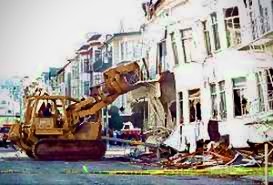
Amid all this chaos and destruction, the emotionally moving Marina walk-through was turning into more of a moving carnival back then. Stunned early risers bearing witness were being overtaken by hopped-up rollerbladers and O-C habitual joggers begrudging the detours. Dazed, clinging couples reorienting amid their smoldering possession were being crowded by site-seeing tourists snapping Kodak moments against said ruins. Smug, thrill-seeking couples from Cow Hollow cited their foresight in leasing on more solid ground; displaced Scott Street residents clutched meager belongings, vowing never to return here, now belonging nowhere at all…
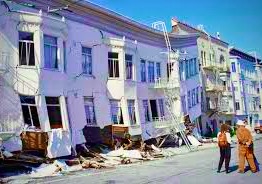
Again, with the era-aches: Back then entered the multimedia hounds: photo-oping shutterbugs, motor-driven staffers, hungry stringers on spec, low-rez videographers with battery packs wearing and weighing them down. Massive network satellite trucks now ringed the perimeter, on-air Eyewitness teams milking the story, while news copters and diverted sports blimps hovered overhead for that signature live-feed panorama. Rumors spread of 70 deaths and counting, as how a dying Quayle was on his way with Bush 41’s blessing, Mayor Agnos to usher Mr. Potatoe Head around for some quick FEMA relief—an earlier iteration of Brownie doing a heck of a job, surveying the Big Easy, beignets and Tasse des Monde in hand.
But all the trespassing, the suspicious poking around seemed to be putting distraught residents even further on edge. Old Marina salts with little left to lose were nevertheless getting territorial. Up to here with inane gaper questions about what it was like, and media ambushes, competing notepads and microphone invasions on ‘how did they feel’, many locals were going from shell-shocked to surly. Incisive, invasive: enough already with the bloodsuckers and bounders. Some homeowners had begun stringing clotheslines, extension cords and knotted sheets around their property lines, hauling besoaked furniture, flooring and whole wardrobes out of sagging abodes while they still could—so many apartment dwellers having no such access for any evac.
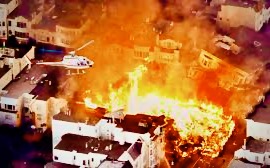
Streets had filled all the more with shock sniffers and idling curious, with assorted roaming rubble rousers, locals along Beach and North Point took to sitting watch on their plaster-dusty sofas and easy chairs, right there out front in what passed for their one-car driveways—vigilantly sizing up the busybodies on parade, culling mere looky-loos from the looky losers and looters. Chain smoking old-timers sat guard with transistor news radios and splintered joist sticks in hand, stank-eyeing the souvenir snaggers and devious skateboarders with bulges in their pockets, not exactly happy to see any of them, wives dutifully salvaging plants, bedding and paintings, or simply standing by, nervously stroking their whimpering butterscotch Papillions.
As rumors swirled of neighborhood vigilante teams forming to sentrify all the vicarious vultures, Marina streets grew less congenial and bicycle circus-like, a bit tenser. Building inspectors were already red-tagging dozens of structures for demolition, barring entry to harried residents with no place else to go. Army troops deployed from the Presidio to quell or contain any spreading disturbances, everybody hyper and under threat of blindsiding aftershocks, or an even Bigger One, courtesy of the San Andreas faultline. Although at least unlike in 1906, these weren’t the wooly doughboys marching in from the Montgomery Street parade grounds—an instant occupying army, making The City’s misfortunes even worse…
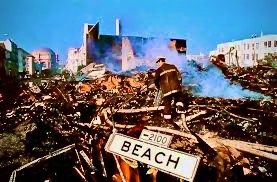
See, then as now I wanted to dig in and help out, I really did. Trouble was, I had this fear gnawing at me that I might be of more assistance back over on Fillmore Street. Truth was, all the yellow crime-scene tape and auxiliary cops shouting ‘move on’ or ‘steer clear of those downed wires’ were taking their toll, as were the sobbing District snobs turned homeless slobs, the buckled sinkholes, the rolling teardowns, the chainsaw brigades uncovering another missing person. Getting to me were so many heaps of soaked mattresses, warped paneling, pulverized dinnerware, sprung cabinetry, legless dinettes and spindled Venetian blinds.
Sparks and cinders combusting in the sooty air, blankets of granulated plaster, pipes seeping sewage, leaky noxious gas fumes set to blow us away: Sirens howled relentlessly toward General and Letterman Hospital; sub-par contractors had already begun sneaking in to reframe, shore up and square off wobbly structures with pounding nail guns, owners winking-and-nodding before city taggers could shut them out. Radio forecasters bulletined that rainstorms would not break the earthquake weather until the weekend, at best. Water remained down, power out…and it was still so stiflingly damn sultry and hot…
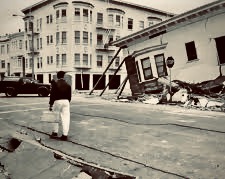
Nope, better then to follow cockeyed street signs and those pole-taped scrawls beseeching the displaced to pull District victims back together again in streetcorner caucuses. Sure, over Fillmore way, where normally price-gouging Chestnut Street shops had set up free coffee and pastries at the Marina Middle School; even Joltin’ Joe DiMaggio might queue up there for some hardship vouchers and post-quake nosh.
And yet, if this bad here, what must it have been like over there? Besides, the road over from North Point, these Tilt-a-Whirl arteries, the roller coaster streets, would likely entail a reckoning with what was said to be the Marina’s Ground 2.0. That would be the thoroughly collapsed chicken coop of a four-story apartment building at 2 Cervantes, spilled like so many crushed egg crates out onto Fillmore Street, with resulting death traps untold, also threatening a cross-corner 76 gas station and its leaching tanks.
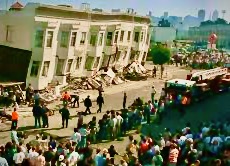
Still, here and thereabouts I dreaded and headed to this day, like walking barefoot on a waterbed, mindful of Richard’s past failings, whether he was genuinely up to the task, myself fixing to looky-loo like crazy for Her—praying for a clean, clear escape, bracing for a rescue operation, fearing a recovery mission of last resort. No, not again—christ, what that had wrought…get on outta…enough, already…STOP it!!!
Return to Chapter 36
Return to Chapter 37




